Input interpretation

ethyl acetate
Chemical names and formulas

formula | CH_3COOC_2H_5 Hill formula | C_4H_8O_2 name | ethyl acetate IUPAC name | acetic acid ethyl ester alternate names | acetic acid, ethyl ester | acetic ether | acetidin | acetoxyethane | ethyl acetic ester | ethyl ethanoate | vinegar naphtha mass fractions | C (carbon) 54.5% | H (hydrogen) 9.15% | O (oxygen) 36.3%
Lewis structure
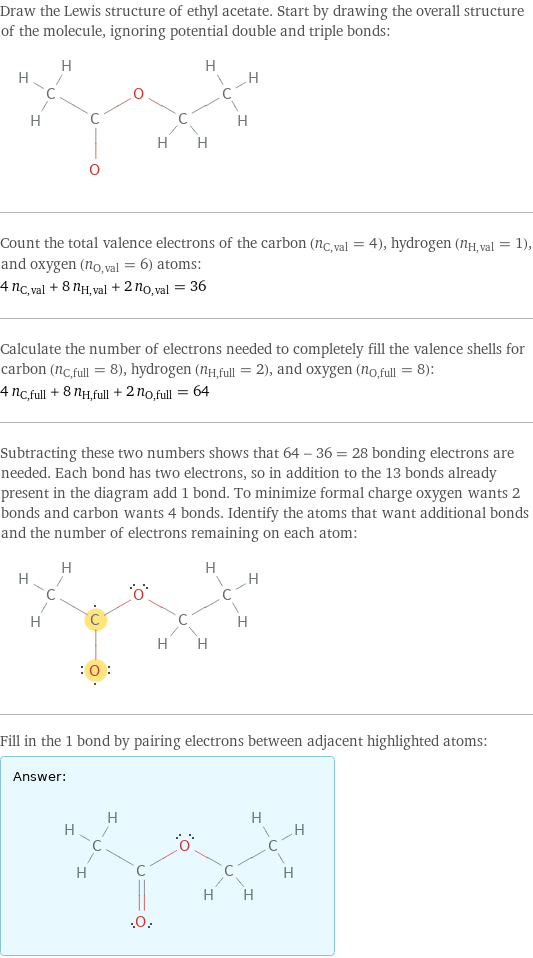
Draw the Lewis structure of ethyl acetate. Start by drawing the overall structure of the molecule, ignoring potential double and triple bonds: Count the total valence electrons of the carbon (n_C, val = 4), hydrogen (n_H, val = 1), and oxygen (n_O, val = 6) atoms: 4 n_C, val + 8 n_H, val + 2 n_O, val = 36 Calculate the number of electrons needed to completely fill the valence shells for carbon (n_C, full = 8), hydrogen (n_H, full = 2), and oxygen (n_O, full = 8): 4 n_C, full + 8 n_H, full + 2 n_O, full = 64 Subtracting these two numbers shows that 64 - 36 = 28 bonding electrons are needed. Each bond has two electrons, so in addition to the 13 bonds already present in the diagram add 1 bond. To minimize formal charge oxygen wants 2 bonds and carbon wants 4 bonds. Identify the atoms that want additional bonds and the number of electrons remaining on each atom: Fill in the 1 bond by pairing electrons between adjacent highlighted atoms: Answer: | |
3D structure
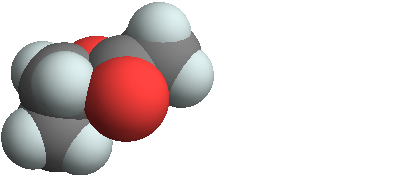
3D structure
Basic properties

molar mass | 88.11 g/mol phase | liquid (at STP) melting point | -84 °C boiling point | 77 °C density | 0.902 g/cm^3 dielectric constant | 6.02
Liquid properties (at STP)
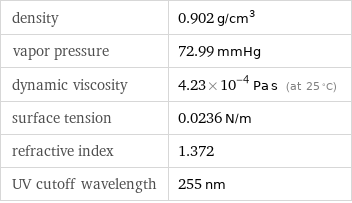
density | 0.902 g/cm^3 vapor pressure | 72.99 mmHg dynamic viscosity | 4.23×10^-4 Pa s (at 25 °C) surface tension | 0.0236 N/m refractive index | 1.372 UV cutoff wavelength | 255 nm
Units
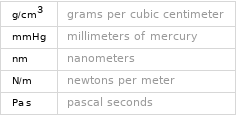
Thermodynamic properties
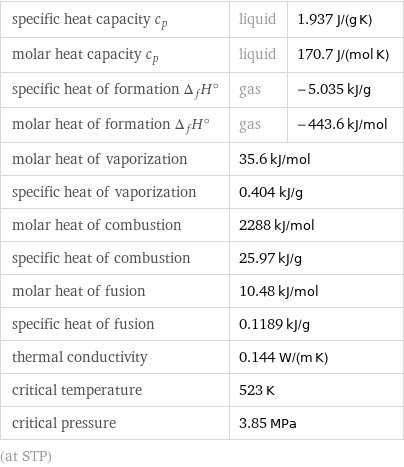
specific heat capacity c_p | liquid | 1.937 J/(g K) molar heat capacity c_p | liquid | 170.7 J/(mol K) specific heat of formation Δ_fH° | gas | -5.035 kJ/g molar heat of formation Δ_fH° | gas | -443.6 kJ/mol molar heat of vaporization | 35.6 kJ/mol | specific heat of vaporization | 0.404 kJ/g | molar heat of combustion | 2288 kJ/mol | specific heat of combustion | 25.97 kJ/g | molar heat of fusion | 10.48 kJ/mol | specific heat of fusion | 0.1189 kJ/g | thermal conductivity | 0.144 W/(m K) | critical temperature | 523 K | critical pressure | 3.85 MPa | (at STP)
Chemical identifiers
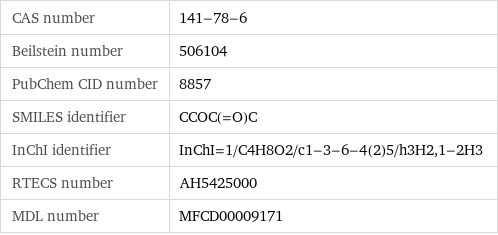
CAS number | 141-78-6 Beilstein number | 506104 PubChem CID number | 8857 SMILES identifier | CCOC(=O)C InChI identifier | InChI=1/C4H8O2/c1-3-6-4(2)5/h3H2, 1-2H3 RTECS number | AH5425000 MDL number | MFCD00009171
NFPA label

NFPA label

NFPA health rating | 1 NFPA fire rating | 3 NFPA reactivity rating | 0
Safety properties
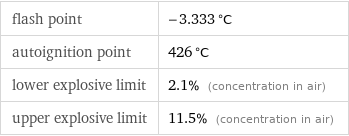
flash point | -3.333 °C autoignition point | 426 °C lower explosive limit | 2.1% (concentration in air) upper explosive limit | 11.5% (concentration in air)

DOT hazard class | 3 DOT numbers | 1173
Toxicity properties
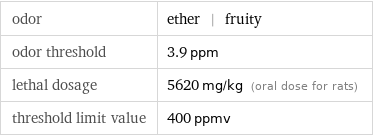
odor | ether | fruity odor threshold | 3.9 ppm lethal dosage | 5620 mg/kg (oral dose for rats) threshold limit value | 400 ppmv

probable lethal dose for man | 1 L (liter) long-term exposure limit | 1400 mg/m^3 (over 8 hours) RTECS classes | agricultural chemical and pesticide | mutagen | human data | primary irritant